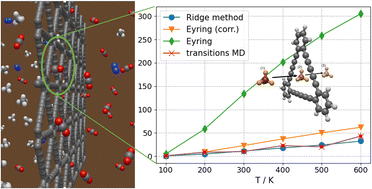The ridge integration method and its application to molecular sieving, demonstrated for gas purification via graphdiyne membranes
Abstract
Eyring theory provides a convenient approximation to the rate of a chemical reaction as it uses only local information evaluated near extremal points of a given potential energy surface. However, in cases of pronounced anharmonicity and particularly low-lying vibrational frequencies, deviations from the correct reaction rate can become substantial. Molecular Dynamics simulations, on the other hand, are very costly at higher levels of theory, and of limited use since molecular reactions are ‘rare’ events and hence statistically less accessible. In this article, we present an alternative description for problems of gas separation and storage via two-dimensional materials such as porous graphene or flat metal–organic frameworks. Taking geometric advantage of the typical problem setting, our method is based on a statistical analysis of molecular trajectories near the so-called ‘ridge’, a hypersurface which divides the reaction volume into a reactant and a product side. It allows for more realistic predictions of permeabilities and selectivities, e.g. derived from density functional theory, but without the considerable costs of a full molecular dynamics simulation on the corresponding Born–Oppenheimer potential energy surface. We test our method on the example of methane separation from nitrogen and carbon dioxide via a graphdiyne membrane.

- This article is part of the themed collection: MSDE Recent HOT Articles


 Please wait while we load your content...
Please wait while we load your content...